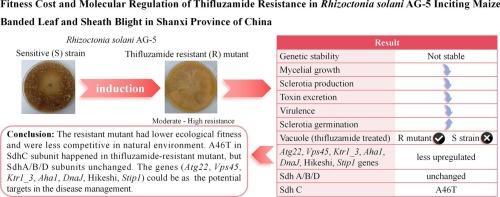Fitness cost and molecular regulation analysis of thifluzamide resistance in Rhizoctonia solani AG-5 inciting maize banded leaf and sheath blight in Shanxi Province of China
IF 4
1区 农林科学
Q2 BIOCHEMISTRY & MOLECULAR BIOLOGY
引用次数: 0
Abstract
Rhizoctonia solani anastomosis group (AG)-5 is the predominant pathogen inciting maize banded leaf and sheath blight in Shanxi province, China, for which the sensitivity baseline to thifluzamide has been established. However, no risk assessment of thifluzamide resistance in R. solani AG-5 has been conducted. Consequently, thifluzamide-resistant mutants of R. solani AG-5 were generated by combined UV irradiation and fungicide selection in the laboratory. Fitness, genetic stability, intracellular structures, and fitness-related differentially expressed genes were subsequently analyzed. Ten resistant mutants were obtained, all of which exhibited moderate-to-high resistance that remained stable for 20 generations. These mutants showed a subtle expansion in their optimal growth temperature and pH ranges as their resistance to thifluzamide increased. Despite this, they exhibited reduced mycelial growth, sclerotia production, melanin formation, and virulence, whereas sclerotia germination rates were higher than in the parental sensitive strain. The mutant Y94.4R maintained vacuole numbers and size post-thifluzamide treatment, whereas the sensitive strain Y94 exhibited vacuole disappearance. Compared to Y94 strain, the expression levels of Atg22, Vps45, Ktr1_3, Aha1, DnaJ, Hikeshi, and Stip1 gene were less upregulated (1.81–3.65 folds) in Y94.4R strain under thifluzamide stress. No amino-acid substitutions were detected in SdhA, SdhB, and SdhD subunits; however, alanine (A) at position 46 of SdhC subunit was replaced by threonine (T) in thifuzamide-resistant mutants. This study showed that the resistant mutants exhibited reduced ecological fitness and competitiveness, suggested that the observed fitness costs might partially support the durability of thifluzamide under field conditions, and provided candidate genes for future disease-management strategies.

山西玉米带状叶枯病的枯核菌AG-5对氟虫胺抗性的适应度成本及分子调控分析
植物根核菌吻合群(AG -5)是引起山西玉米带状叶鞘疫病的主要病原菌,已建立了对氟虫胺的敏感性基线。然而,尚无索拉尼革螨AG-5对氟沙胺耐药的风险评估。因此,在实验室中,通过紫外照射和杀菌剂选择相结合的方法,产生了茄茄霉AG-5抗氟虫胺突变体。随后分析了适应度、遗传稳定性、细胞内结构和与适应度相关的差异表达基因。获得了10个耐药突变体,均表现出中高抗性,并在20代内保持稳定。这些突变体随着对硫氟沙胺抗性的增强,其最佳生长温度和pH值范围有细微的扩大。尽管如此,它们表现出菌丝生长、菌核生成、黑色素形成和毒力的减少,而菌核发芽率高于亲本敏感菌株。突变体Y94.4R在氟唑胺处理后液泡数量和大小保持不变,而敏感菌株Y94液泡消失。与Y94相比,在硫氟唑胺胁迫下,Y94.4R菌株的Atg22、Vps45、Ktr1_3、Aha1、DnaJ、Hikeshi和Stip1基因的表达量上调幅度较小(1.81 ~ 3.65倍)。在SdhA、SdhB和SdhD亚基中未检测到氨基酸取代;然而,在硫脲胺耐药突变体中,SdhC亚基46位的丙氨酸(A)被苏氨酸(T)取代。该研究表明,抗性突变体表现出较低的生态适应度和竞争力,表明观察到的适应度成本可能部分支持氟唑胺在田间条件下的持久性,并为未来的疾病管理策略提供候选基因。
本文章由计算机程序翻译,如有差异,请以英文原文为准。
求助全文
约1分钟内获得全文
求助全文
来源期刊
CiteScore
7.00
自引率
8.50%
发文量
238
审稿时长
4.2 months
期刊介绍:
Pesticide Biochemistry and Physiology publishes original scientific articles pertaining to the mode of action of plant protection agents such as insecticides, fungicides, herbicides, and similar compounds, including nonlethal pest control agents, biosynthesis of pheromones, hormones, and plant resistance agents. Manuscripts may include a biochemical, physiological, or molecular study for an understanding of comparative toxicology or selective toxicity of both target and nontarget organisms. Particular interest will be given to studies on the molecular biology of pest control, toxicology, and pesticide resistance.
Research Areas Emphasized Include the Biochemistry and Physiology of:
• Comparative toxicity
• Mode of action
• Pathophysiology
• Plant growth regulators
• Resistance
• Other effects of pesticides on both parasites and hosts.

 求助内容:
求助内容: 应助结果提醒方式:
应助结果提醒方式:


